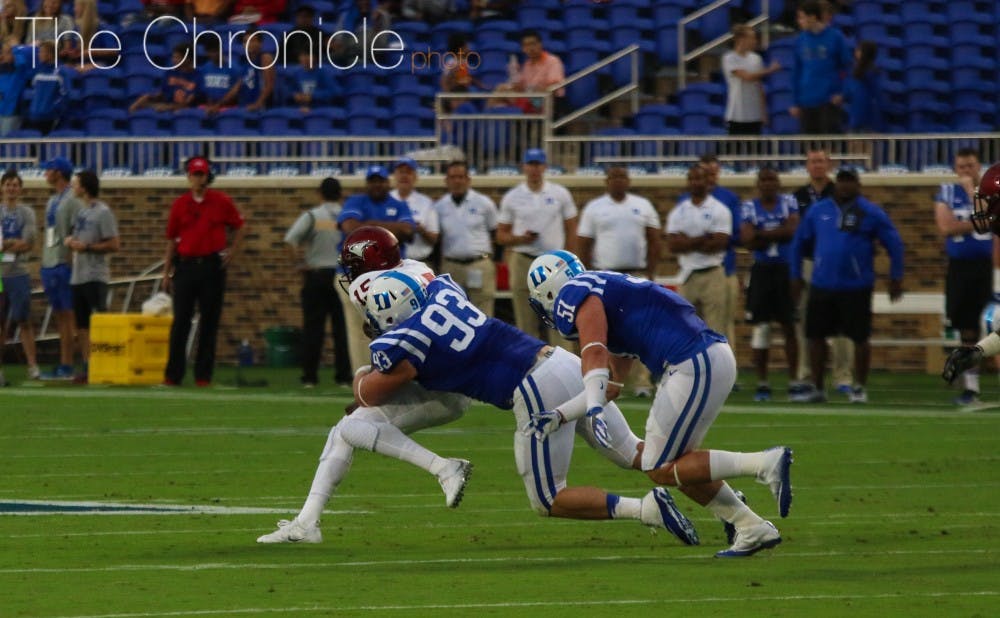When Duke hired Ben Albert as the team’s defensive line coach last February, it was the start of an evolution for the Blue Devil defense.
Just one year after Duke was one of the worst defensive units among FBS teams, the Blue Devils currently rank third in the ACC with 20 sacks, trailing only Pittsburgh and No. 3 Clemson.
And with redshirt freshman Daniel Jones under center and an inexperienced offensive line this season, the Blue Devils have leaned on their defense to battle to a .500 record through their first six games.
“It’s more of a mentality thing than it’s been in the past,” redshirt senior defensive tackle A.J. Wolf said. “We know what Coach Albert has brought to the defense—we just really want to get after the quarterback every play, not just third-and-long.”
Wolf has combined with sophomore Ben Humphreys and redshirt freshman Joe Giles-Harris—both leaders of a young linebacker corps—for 8.5 combined sacks and the three are part of a Duke front seven that is drastically improved across the board.
But as was the case in 2015, the Blue Devils have been plagued by long-yardage plays throughout the first half of the 2016 season. And they have not yet faced a ranked opponent—four of which they will face in their last six games.
On the whole, Duke ranks well in most major defensive statistical categories, but a deeper dive reveals that frequent big plays have hurt the unit in nearly every game.
In the Blue Devils’ consecutive losses against Wake Forest and Northwestern earlier this season, Duke’s opponents racked up total of 148 offensive plays for 795 yards. Seventeen of those plays were 15 yards or longer and accounted for 534 yards—more than two-thirds of the Demon Deacons’ and Wildcats’ combined offense.
The Demon Deacons scored their game-sealing touchdown on a 55-yard run and in Evanston, Ill., the Wildcats' trio of touchdown passes came on plays of 26 yards or more. But on the other 88.5 percent of offensive snaps, Wake Forest and Northwestern averaged a meager 2.0 yards per play.
Even in its win against Notre Dame, Duke surrendered 16 plays of 15 yards or more to the Fighting Irish, who finished with an average of 7.2 yards per play. Although the Blue Devils sacked Notre Dame quarterback DeShone Kizer four times, the junior consistently found time to strike deep downfield and kept Notre Dame alive, even with an average of less than 3.5 yards per play on its other 58 offensive snaps.
The following week, Duke allowed an 84-yard pass to Virginia wide receiver David Eldridge, setting up the Cavaliers’ second touchdown of the afternoon. Even last weekend, the only score Army had against the Blue Devils came on a 45-yard scamper by Black Knight running back Andy Davidson.
Although the work of Albert’s revamped unit has given Knowles the freedom to dial up even more pressure, big plays have hurt a Duke defense that has had its moments—like a big-time final stop in South Bend and several crucial 4th-down stops against Army last weekend.
“When you’re unblocked, you have to make the play because when a blitz is called, coverages are different [and] someone’s going to be open if you give them enough time,” Humphreys said. “You have to get there, and go 110 percent through the line and just try to make a play.”
Even a top defense like Alabama still surrenders 4.2 yards per play. If the Blue Devils could just sustain their strong defense even a little more frequently, they might have an extra win or two at this point in the season and would be in good position to make a fifth straight bowl game.
Of course, in Duke's losses, the offense has not done the team any favors, but for the Blue Devils to take the next step, their defense will have to be more consistent in addition to creating momentum-changing plays.
On Friday, Duke will head to Louisville to face the No. 7 Cardinals and Heisman Trophy frontrunner Lamar Jackson. A dual-threat quarterback, Jackson has already racked up more than 2,300 all-purpose yards this season and is averaging 8.8 yards per play.
And with Miami, Pittsburgh, Virginia Tech and North Carolina—all of which average more than 400 offensive yards per game—remaining on the team's 2016 slate as well, the Blue Devils better find a way to limit explosive plays.
There’s no question that Duke football is in a better place than it was a decade ago. In 2006, the Blue Devils were winless in 12 games and earned victories in just nine games from 2007 to 2009.
Yet as the team fights through what will likely continue to be a difficult 2016 season, it will have the opportunity to lay the foundation for future success if it can continue improving defensively from one of the nation's worst to one that its opponents fear.
With a young linebacker corps that will return Humphreys and Giles-Harris next season along with a deep rotation along the defensive line, the Duke front seven will likely keep developing.
But the Blue Devils will only be consistent contenders in the ACC if they can avoid the lapses that lead to chunk plays.
Hank Tucker contributed reporting.
Get The Chronicle straight to your inbox
Signup for our weekly newsletter. Cancel at any time.
Twitter: @mpgladstone13
A junior from just outside Philadelphia, Mitchell is probably reminding you how the Eagles won the Super Bowl this year and that the Phillies are definitely on the rebound. Outside of The Chronicle, he majors in Economics, minors in Statistics and is working toward the PJMS certificate, in addition to playing trombone in the Duke University Marching Band. And if you're getting him a sandwich with beef and cheese outside the state of Pennsylvania, you best not call it a "Philly cheesesteak."

